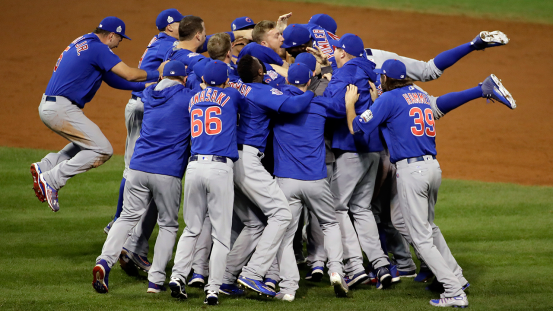- Commissioner’s statement on Ventura, Marte
- Ronnie O’Sullivan: Masters champion ‘felt so vulnerable’ in final
- Arron Fletcher Wins 2017 WSOP International Circuit Marrakech Main Event ($140,224)
- Smith challenges Warner to go big in India
- Moncada No. 1 on MLB Pipeline’s Top 10 2B Prospects list
- Braves land 2 on MLB Pipeline’s Top 10 2B Prospects list
- Kingery makes MLB Pipeline’s Top 10 2B Prospects list
- New Zealand wrap up 2-0 after Bangladesh implosion
- Mathews, Pradeep, Gunathilaka to return to Sri Lanka
- Elliott hopes for rain for Poli
Game 7 capped ’16 with magical masterpiece
- Updated: January 2, 2017

CLEVELAND — The last piece of plastic had just been hung. Here, in the late haze of an unseasonably warm early November night, roughly 20 people — a collection of clubhouse employees, ballpark maintenance workers and Major League Baseball personnel — had done their diligent and scoreboard-appropriate work to turn the visiting clubhouse at Progressive Field into the soon-to-be-champagne-soaked stage where 108 years of angst and agony would be literally wiped away.
All proper signage and security had been accounted for, and this now-plastic-wrapped room was four outs away from serving its party purpose.
Take 10: Top stories of 2016 Rockies’ Story wrote long-ball tale Scherzer’s 20-K gem one for the ages Wild October caps “Year of Reliever” Ichiro makes history again Baby Bombers make mark Vin delivers memorable farewell Altuve achieves elite status Big Papi calls it a career Cubs fans on top of the World Jan. 1: Game 7 caps amazing season
Then, Cubs lefty Aroldis Chapman threw a 97 mph four-seamer at the knees of Indians speedster Rajai Davis, who smacked a frozen rope toward the left-field corner that carried, carried, carried and, stunningly, cleared the 19-foot-wall.
With the ballpark shaking and its denizens — an unusually even assortment of both home and away fans — either stomping their feet in celebration or putting hands to head in stunned disbelief, the group assembled in the visitor’s locker room had no time to process those two sixes in the runs column.
“We’ve got to get to the home side!” somebody yelled.
And off they sprinted down the concrete hall in the bowels of the building, to the Tribe’s side, where another, more slapdash round of plastic-wrapping began.
Game 7, already destined to be a classic purely because of its historical significance, had just become an epic on its own on-the-field merits.
It has been 60 days since the Cubs and Indians gave us this winner-take-all wonder on a Wednesday night, 60 days since the Cubs overcame Davis’ late-inning heroics and their own organizational aura of error to complete their 8-7, 10-inning, rain-delay-aided victory and 2016 saga.
We have ventured into a new year now, one that will uncover its own heroes and make its own magic.
But pardon us if we can’t fare into the future without one more round of applause for the recent past, for a single, solitary night of baseball that heartened, haunted or simply stimulated all those who witnessed it either in the stadium, on the screen or via the frenzied, thumb-perking power of social media.
It’s a story that will forever be worth re-telling.
The setup
That 4-hour, 28-minute Game 7 was an instant classic, but it was a messy masterpiece. And in it, the weight of history, the urgency of the occasion, the authority of Mother Nature and the two clubs that were, unpredictably, evenly matched all congealed in a landscape of awesome absurdity.
Begin with the stakes themselves — the Cubs’ Major League-leading 108-year curse juxtaposed against the Indians’ own American League-leading 68-year wait. That the game’s two most formidable famines encountered each other on the Series stage made for easy marketing. That the Series itself went the distance, with the finale extended to an extra inning that itself was delayed by rain, was both unfathomable and absolutely appropriate.
But there was more.
The Indians had held a 3-1 edge in this Series, something 40 teams in 45 tries had turned into a title in a best-of-seven. But 3-1 was the very deficit the next-door-neighbor Cavaliers had overcome in June’s NBA Finals, which had delivered this city its first major professional title in 54 years.
The Cubs mounted their own comeback when Chapman got eight clutch outs on a chilly Sunday night at Wrigley Field in Game 5, and when an opportune offense steamrolled its way to a 9-3 win on the first night of November.
That gave us the Game 7 this Series deserved.
The game-time temperature was 69 degrees, both encouraging a local “Indian(s) Summer” sentiment and disproving the theory that November baseball is a negative.
Instead, another upstart theory — that the World Series should be played on a neutral stage — was oddly put into practice. Cubs fans put a lifetime’s worth of savings to good use on the secondary market to scoop up what could reasonably be estimated to be 50 percent of seats. And so, if you were in the building and had only your ears to inform you of the events taking place on the field, you legitimately would not know if what happened on the fourth pitch of the ballgame was good or bad for the local nine.
It was bad. Dexter Fowler sent Corey Kluber’s 2-1 offering over the wall in dead center.
“They’ve been telling me all year,” Fowler would say later, “‘You go, we go.'”
Up the Cubs went, 1-0.
The Indians would answer in the third, on a Carlos Santana RBI single off Cubs starter Kyle Hendricks. But from there, more Cubs clout arose. Kluber was operating on short rest for the second time in the Series and the third time in the postseason, an applaudable effort at overcoming the injuries …
